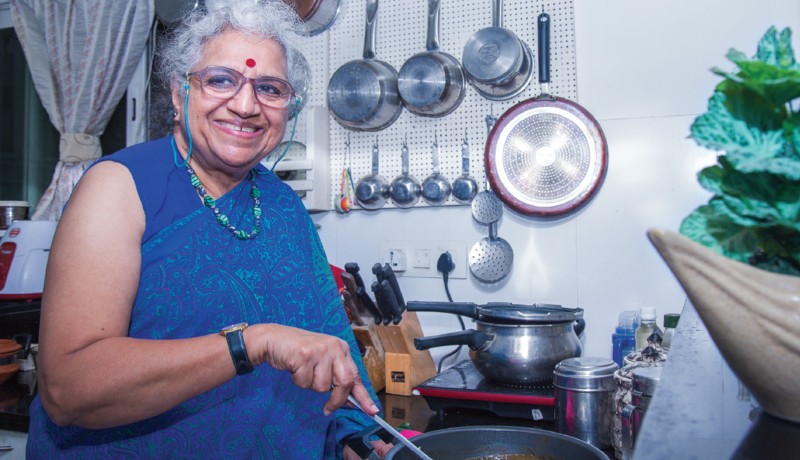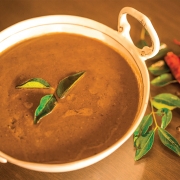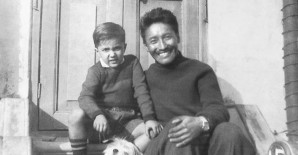
Columns

A series by Pratibha Jain about silvers who believe nurturing the body and mind is the key to joy.
Featuring Chandra Padmanabhan from Chennai
It was back in 1992 when I received a birthday gift that sparked my interest in south Indian cuisine. It was Chandra Padmanabhan’s Dakshin, which went on to become a bestseller among cookbooks. I tried one recipe after another and encouraged by the positive feedback, I went on to cook an entire saapad (full meal) for my guests on a Sunday morning, with only Chandraji’s book as my guide. The elaborate meal was a roaring success, and won me great applause and confidence. At 27, that recognition in the family mattered a lot. Years later, when we finally met in person, I was simply overawed by Chandraji’s charming persona. With her sparkling energy and passion, it is little wonder that, at 75, Chandraji remains one of India’s finest cookbook authors today. Her cookbooks—Southern Spice, Simply South and Dosai—have received rave reviews with the last two winning the Gourmand World Cookbook Awards.
IN HER OWN WORDS
I was born an Iyengar but lived in various metropolitan cities through my life, which heavily influenced my cooking style. My parents also enjoyed experimenting with a mixture of cuisines while living abroad. Even though I define my cooking as a khichadi, there is predominantly an influence of Thanjavur cuisine. I learnt to cook from my mother-in-law, whose family came from Thanjavur. She was a brilliant cook and I used to watch her and document her recipes. She did not follow any accurate measures but cooked by instinct. I would ask her to set aside the quantities being used and then measure them to evolve the perfect recipe. My interest deepened and I became an avid learner, observing others whose cooking I admired. This experience inspired me to become a cookbook author.
THE LITERARY JOURNEY
I think my love for writing and editing began because my husband was in the publishing industry. He started the publishing house East West, now known as Westland, in Chennai. I was one of the directors and became involved in editing manuscripts as well. During that time, I noticed a dearth of cookbooks on south Indian cuisines. Somewhere along the way, I decided to fill the gap and Dakshin was born. Readers loved it and my journey continued.
HOW RECIPES EVOLVE
My mother-in-law used to say, “Each family has its own recipes depending on what the members like. But primarily, all family recipes are patriarchal.” She was right! My father-in-law disliked seeing tomatoes in his dal and rasam, so my mother-in-law used to boil the tomatoes and make a puree before adding it to the dishes. Most of her recipes call for tomato puree. As she taught the next generation, that became a tradition.
THE MARATHA INFLUENCE
Due to Thanjavur becoming the heartland of Tamilian Brahmins, almost all of its famous recipes are Brahmin recipes. Some of my favourite traditional Thanjavur recipes are vattal kozhumbu and karvepillai kozhumbu. However, Thanjavur Brahmin cuisine has a lot of Maharashtrian elements to its recipes as well. Almost 250 years ago, when the Marathas settled in Thanjavur, they brought with them their culture and other influences. Getting its name from King Samboji, sambar is a popular Thanjavur dish that has only existed for the past two centuries. Also recipes such as vangi bath and rasa vangi are Maharashtrian influences on south Indian cooking as the term vangi itself is a Marathi word.
TRADITIONAL FOOD PRACTICES
Our elders often spoke of how healthy and rich their food was. Nutrition was an important factor in their cooking. The lifespan may have been shorter, but their existence was healthier and more holistic. Pure cow’s ghee was aplenty then and used extensively in cooking. So were nuts. I have seen my mother-in-law adding cashew nuts to dishes like vattal kuzhambu. In those days, adding peanuts and cashew nuts to dishes, including tempering, was a common practice.
MY FOOD GUIDE
There are some simple food practices that I have retained over time. I believe in having a sumptuous breakfast every morning. I include buttermilk and curds in my meals compulsorily. I avoid dals and greens at night. I feel people should return to how they ate as children. When we were young, the entire family would have a sit-down meal (lunch) at 10 am every morning. Then, around 2 pm, tiffin would be served. Nowadays, many youngsters say they do not have time for a good breakfast. Can we really make that choice when it is not healthy to do so? This is exactly why I wrote Dosai, which features over 100 dosai recipes such as instant dosai and millet dosai. I took into account existing health conditions and did adequate research to compile these recipes.
MY MASALA DABBA
It is an indispensable part of my kitchen. You may not believe it but the round, quintessential masala dabba with seven containers is not a traditional practice. Our ancestors used a square dabba with more items. The cooking was also done in larger portions. But for today’s generation, I recommend the masala dabba. It is handy and makes cooking an efficient procedure. I store chana dal, urad dal, mustard, fenugreek seeds, coriander seeds, cumin seeds and turmeric powder in my masala dabba; red chillies are kept on the inner lid.
MY FAMILY HEALTH SUPPLEMENT
My father’s family did not drink tea or coffee; they consumed a health drink called pazhayadu instead. This is made by soaking leftover rice in water overnight. The next morning, it is mixed with buttermilk and consumed with pickle. The fermentation process that takes place at night makes this a healthy, everyday option. Pazhayadu is a strengthening supplement that helps prevent inflammation and acidity.
INDEPENDENT AGEING
My son Gautam, who now heads Westland, daughter-in-law Savitha and grandson Amithav live close by and take good care of me while still allowing me to have my independence and be my own person. I enjoy being active on social media. I keep myself busy and enjoy meeting family and friends over lunches, club meetings, and book club events. I am indeed blessed.
KARVEPILLAI KUZHAMBU
(Curry leaves sambar)
Though most people love the flavour of curry leaves, as Chandraji says, very few people consume the leaves; many have the tendency to pick out the leaves from dishes and set them aside! This traditional recipe from Chandra Padmanabhan’s kitchen has curry leaves ground with spices, thus enhancing the flavour while retaining the health benefits.
Ingredients
- Red chillies: 5-6; dried
- Black peppercorns: 1 tsp
- Cumin seeds: ½ tsp
- Asafoetida powder: 1 tsp
- Black gram dal: 2 tsp
- Uncooked rice: 1½ tsp
- Tamarind (without seeds or strings): lime-sized
- Curry leaves: ½ cup; tightly packed
- Salt to taste
For tempering
- Gingelly oil: 2 tsp
- Mustard seeds: 1 tsp
- Fenugreek seeds: ¼ tsp
- Red chilli: 1 dried; halved
Method
Dry-roast the red chillies, peppercorns, cumin seeds, asafoetida powder, black gram and rice. Fry over low heat, tossing gently, till fragrant. Cool and add the curry leaves and tamarind. Grind to a fine paste, adding very little water. Dissolve the ground paste in 2 cups of water. Add salt and set aside. Heat 2 tbsp of gingelly oil. Add all the ingredients for tempering. When the mustard seeds splutter, add the dissolved paste and simmer till it thickens. Serve hot with rice and roasted papad.
|
Curry leaves are widely used in south Indian cuisines for their pleasant aroma and health benefits—they are rich in calcium, iron, phosphorus, copper and magnesium, and a good source of vitamins A, B, C and E. They also have antioxidant properties, helping prevent several diseases.
|
|---|
Pratibha Jain, an author and translator from Chennai, is the co-author of two award-winning books Cooking at Home with Pedatha and Sukham Ayu. Her area of specialisation is documenting Indian traditions through research, translation and writing
Photos: D Kalaiarasan Featured in Harmony — Celebrate Age Magazine May 2018
you may also like to read
-
Mental workout
Mukul Sharma tells you how to keep those grey cells ticking Everyone will ultimately lose his or her brain….
-
Helpline
Dr Harshbir Rana answers your queries on personal and social issues related to ageing, elder care and intergenerational relationships ….
-
Off the cuff
Raju Mukherji pays tribute to his first hero, Tenzing Norgay, an exemplary mountaineer Darjeeling, 1955. Dr ‘Pahari’ Guha Mazumdar….
-
Yoga RX
Shameem Akthar shows ways to control debilitating ankle pain through regular practice Ankle pain is so common and prevalent….








